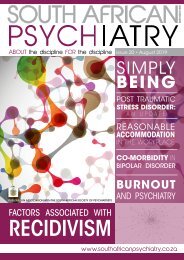South African Psychiatry - February 2019
South African Psychiatry - February 2019
South African Psychiatry - February 2019
Create successful ePaper yourself
Turn your PDF publications into a flip-book with our unique Google optimized e-Paper software.
FEATURE<br />
YEARS LIVED WITH DISABILITY (YLDs)<br />
The GBD studies use the term ‘disability’ to refer to a<br />
loss of optimal health in any of the important health<br />
domains. YLDs quantify functional health loss utilising<br />
the prevalence of a disease or injury state and a<br />
measure of the severity of disability (a disability<br />
weight) caused by that state (i.e. YLD = prevalence<br />
of the disease x disability weight for that disease).<br />
The 1990 GBD study used incidence of disease and<br />
injury but this was changed to prevalence by 2010,<br />
as the use of incidence involved calculations of<br />
prospective average duration of disease. Prevalence<br />
data capture the loss of health at the age at which<br />
it occurs rather than the age at which the disease<br />
is incident.<br />
ADDITIONALLY, PREVALENCE DATA ARE<br />
MORE COMMONLY COLLECTED AT<br />
COUNTRY-LEVEL, AND BETTER ENABLE<br />
ADJUSTMENTS FOR COMMONLY<br />
COMORBID CONDITIONS TO PREVENT<br />
OVERCOUNTING OF DISEASE BURDEN.<br />
THE HIGH COMORBIDITY BETWEEN<br />
DEPRESSION, ANXIETY AND SUBSTANCE<br />
USE DISORDERS IS INCORPORATED BY<br />
COMBINING THE YLDS CALCULATED FOR<br />
EACH OF THE CONDITIONS.<br />
The disability weight is numerical value determined<br />
by using surveys of the general population, where 0<br />
= a state of perfect health, and 1 = a state equivalent<br />
to death (Table IV). It is similar to a Quality Adjusted<br />
Life-Year (QALY), a measure related to loss or gain<br />
of quality of life used by health economists. It<br />
should reflect or quantify the loss of “healthfulness”<br />
caused by the disease or injury. It should not be<br />
a value judgement related to quality of life, the<br />
worth of a person, social undesirability or stigma.<br />
Nevertheless, there is still uncertainty around the<br />
weighting of a disability. For example, substance<br />
dependence, although better defined in the GBD<br />
2015 study to prevent the influence of social values,<br />
may still be affected by perception of disability. It<br />
is possible the more severe weighting for heroin vs<br />
amphetamine dependence may be related to the<br />
distressing withdrawal symptoms reported by heroin<br />
users. However, while amphetamine users may not<br />
perceive their addiction to be so disabling, it may<br />
result in greater psychiatric symptomatology, violent<br />
behaviour, and medical and psychiatric hospital<br />
admissions, which might not be captured in the<br />
disability weight.<br />
Another aspect of the disability weight is the<br />
adaptation by society to that disease state. Hence,<br />
it is possible that where there is a high level of<br />
adaptation to, for example, visual or hearing<br />
impairment, these states may not be as disabling as<br />
in societies which offer little or no assistance to blind<br />
Source: WHO methods and data sources for global burden of disease estimates 2000-2015 1<br />
Table IV Comparison of GBD2010, GBD2015 and revised GHE disability weights.<br />
SOUTH AFRICAN PSYCHIATRY ISSUE 18 <strong>2019</strong> * 9
















